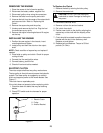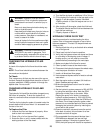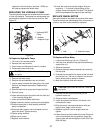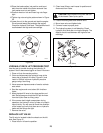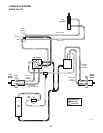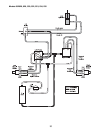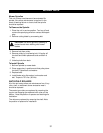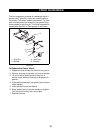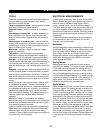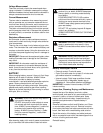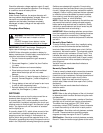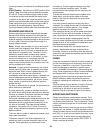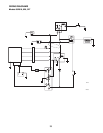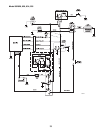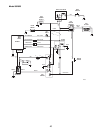
33
TOOLS
There are some specialized tools and test equipment
that are needed for electrical repair work. A brief
description of these follows.
Long or needle nose pliers - used to connect or bend
wires and connectors in close quarters.
Diagonal cutters - used to cut wires or trim connec-
tions.
Wire stripper/crimping tool - available separately or
as a combination tool. Used to strip insulation from
wires of various sizes, crimp terminals and connector
or wires.
Soldering gun or soldering iron - used to solder all
splices and connections to terminals, connector, etc. A
soldering gun is faster and more convenient that wait-
ing for a soldering iron to heat.
Multimeter - analog or digital, to measure voltage,
amperage and ohms.
Tachometer - used to measure engine speed.
Required to properly test alternator and charging cir-
cuits where output is dependent upon engine speed.
Heat gun - used to shrink insulated tubing in place.
Used to replace electrical tape or insulated sleeving. To
use, place a piece of shrink tubing over a wire joint,
heat with the heat gun, until it shrinks tightly around the
joint.
Supplies - electrical tape, rosin core solder (never use
acid or acid core solder on electrical joints), an assort-
ment of various size terminals, connectors, insulated or
heat shrink tubing (for use on joints and connections),
and an assortment of automotive type wire (in several
colors).
Gravely Company recommends that all work be done
in a professional manner. The use of the tubing to
cover joints and the soldering of connections contribute
to a professional looking job. In addition to a pleasing
appearance, repairs made in this manner are more
likely to withstand vibration. The weakest points in an
electrical system are the joints where wires are
attached.
Replace all defective components with Gravely
replacement parts only. Engine parts, such as rectifiers
or alternator components should be secured through
the nearest engine service center.
Gravely Company does not recommend attempting to
repair electrical components. Most do not lend them-
selves to repair and you would have more money
invested in "time of repair" than the part would cost and
the results may not be as good.
ELECTRICAL MEASUREMENTS
In many electrical circuits, there is some visible effect
which indicates that the circuit is functioning properly. A
switch is turned "ON" and a lamp lights. A key is
turned, a starter motor runs and cranks the engine.
If the lamp does not light, or the starter motor does not
run, some means of measuring voltage, current flow,
resistance and continuity is needed, (continuity means
there is a complete electrical path through the circuit or
component.)
To know exactly what conditions exist in an electrical
circuit requires AC and DC Voltmeter, AC and DC
Ammeter, and an Ohmmeter.
Multimeter
A single combination meter that does all of these things
is available. Such a meter is called a Multimeter or Volt-
Ohm-multitester (VOM). Meters of this kind are avail-
able in many forms and all change functions and
ranges with switches, or by plugging test leads into dif-
ferent jacks. Multimeters are available in two basic
types, Analog and Digital.
Analog Meters
Analog Meters have a needle that moves across a
scale to give a reading. The longer the scale, the easier
it is to read and more accurate the reading will be. A
jeweled movement used in this type of meter is more
likely to be damaged through rough handling (except
for overloaded Protected Meters) or by measuring high
values that exceed the range set on the meter than a
digital meter. They provide excellent service for the
money as long as they are used with care.
Digital Meters
Digital Meters do not have a movement and are there-
fore more rugged. The reading shows up directly on a
display window of some type. Since they read direct,
no skill in reading the scale is required, nor is it neces-
sary to set the range. The meter switches the ranges
automatically. One has only to select the function DC
Volts, AC Ampere, Ohms, etc.,) connect the test leads,
and the reading is shown on the display. Because of
the internal circuitry and the lack of a movement, these
meters are not likely to be damaged by overloads.
In the discussions that follow, either type of meter may
be used. Test procedures are the same. It is best to
learn proper procedures, even though some meters
may be more forgiving of mistakes. Where differences
in use may occur, they will be covered in the discus-
sion.
ELECTRICAL



